THE HIGHLANDS OF SCOTLAND September 2006
 Wednesday, April 8, 2015 at 12:51PM
Wednesday, April 8, 2015 at 12:51PM Our hike in Scotland began with a lesson learned the hard way. When our luggage failed to arrive with us in Edinburgh, we chose to wait for it in the city rather than setting off on the walk with the rest of the group. We could easily catch up with them the next day in Drymen. On the map, it didn't appear to be too far from Edinburgh, and we naively thought that the clauses in our conscientiously purchased insurance policies dealing with “delayed baggage causing interruption of travel plans” and covering “transportation to the next point on the itinerary” justified our hiring a car and driver to get us there. Luggage finally retrieved, we enjoyed a long and comfortable drive across what turned out to be a good chunk of Scotland, chatting merrily with our driver and utterly unperturbed by the significant costs we were incurring - only to have our claim denied when we got home. The insurance company argued that our bodies had arrived in Edinburgh and those bodies were perfectly capable of heading out with the group. The luggage, they insisted, would have been forwarded to us at no charge had we chosen to play by the rules.
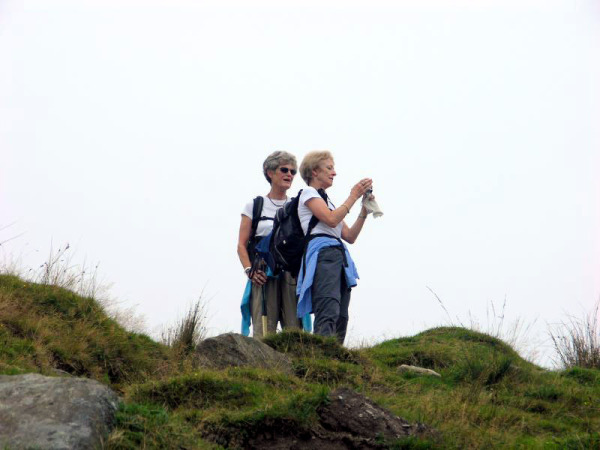 Ellie and Suzy
Ellie and Suzy
It was a financial miscalculation, but a small price to pay for the extra day it gave us in “Auld Reekie,” as Edinburgh used to be nicknamed. (“Reekie” means “smoky,” but thanks to the passage of several Clean Air Acts, the city no longer is.) We would happily have spent longer there, but by the next evening we and our luggage had been reunited with our little group of six hikers in the hotel in Drymen. Our timing was fortuitous; there happened to be a ceilidh (pronounced “kaylee”) that evening, and the locals were pouring into the hotel for an evening of music and dancing. They, of course, knew exactly how the dances (similar to country dances) were to be done, while we had no idea. However, gallant partners immediately welcomed us and insisted that we join in, politely amused by our missteps, and urging us on as we tried to get the hang of it. Danced properly, it's probably quite challenging; doing it on our level was just great fun.
The next day we got down to business with an ascent of Ben Lomond. The climb started off with a lovely view over Loch Lomond – as romantic a sight as the song suggests. However, Scotland being Scotland it was only a matter of time before we entered the mist and it was one foot in front of the other until we reached the summit (3,100 feet).
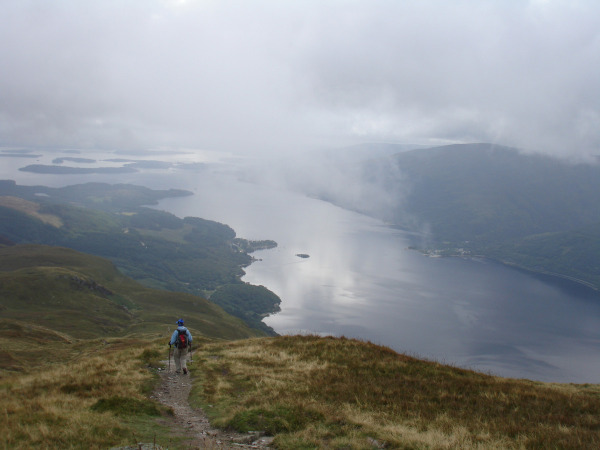 Loch Lomond
Loch Lomond
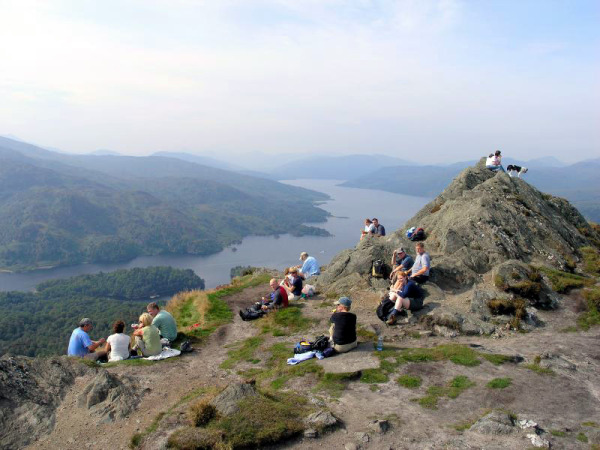 Summit of Ben Lomond
Summit of Ben Lomond
Our next stop was Glencoe. Like so many places in Scotland, it is a serenely beautiful spot with an turbulent history: the Massacre of Glencoe in 1692. Nearby we scrambled over a rough path of large rocks before suddenly finding ourselves in The Lost Valley (Coire Gabhail). Shielded from detection by the mountains in front of it, the valley was a perfect place for local clansmen to hide their cows (or more likely cows they had stolen) when under attack.
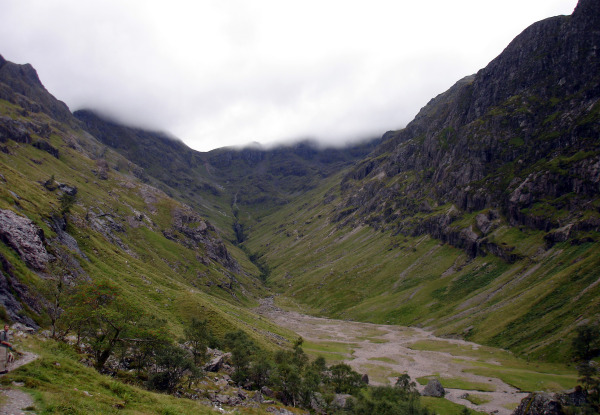 The Lost Valley (Coire Gabhail)
The Lost Valley (Coire Gabhail)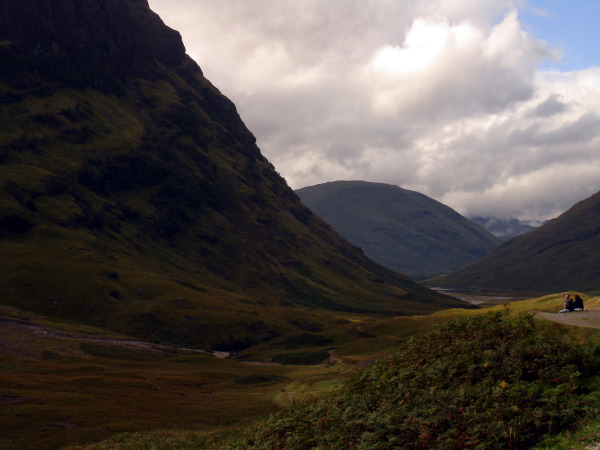 Glencoe
Glencoe
And then things got really serious. We were to make an attempt on 4,409 ft. Ben Nevis, the highest mountain in the United Kingdom. The Ben, as it is affectionately known, also features sheer cliffs, and weather. It was this latter that doomed our endeavor; our guide had been instructed to bring us back alive, and with winds of around 50 mph on exposed ground, he wasn't confident about doing that. But he agreed to keep our options open until we had had lunch and to reassess the situation then. We sought shelter for that at a deserted first aid hut, and it was there that an observant fellow hiker noticed that the sole of one of Suzy's boots was detaching itself from the boot itself. Our ever helpful guide took the boot, and using lots of tape and ingenuity, managed to reattach the sole to the boot. Unfortunately he performed this feat of engineering when there was no foot in the boot, and although it was a fine repair job, when he had completed it there was no possibility of inserting a foot into the boot, now securely taped in every direction. Back to the drawing board. Eventually he came up with a solution that would get her back down the mountain, but between boot and weather, the summit idea had to be scrapped. Our disappointment was mild at the time; we regret it a lot more now that we are warm and out of the wind. Luckily there was a sporting goods store in Fort William the next day, with a helpful and knowledgeable young saleswoman. Buying new boots in mid-hike is usually a really, really dumb thing to do, but the hiking gods were with her; those spur-of-the-desperate-moment boots have covered many comfortable miles since then.
We were to spend the next three days on the Isle of Skye, so we made our way to the small port of Mallaig, where we would catch the ferry to the island. We stopped (briefly, because of an unrelenting downpour) to admire the Glenfinnan Monument. Erected in 1815, the figure atop the column may or may not be Bonnie Prince Charlie, and the spot may or may not be the actual spot where he raised his standard in an attempt to claim the throne of England and Scotland for his father, James VIII or James II, depending on which side of the border one lives. But the haunting beauty of the location, isolated and moody, near the shore of Loch Shiel, is indisputable.
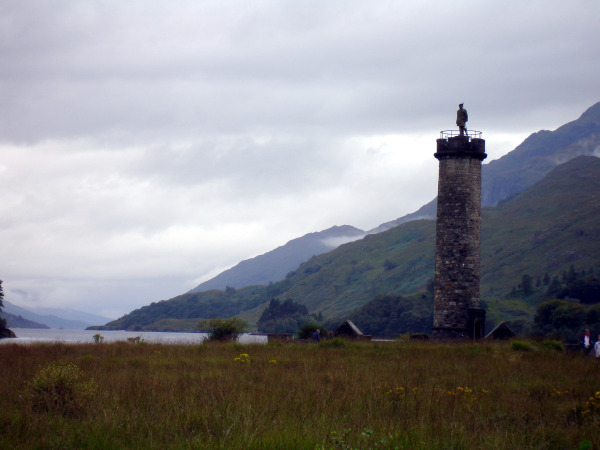 Glenfinnan Monument
Glenfinnan Monument
The ferry between the mainland and the island takes only twenty-five minutes, always within sight of land. It took much longer to drive from the port of Armadale to the island's major city, Portree. Or, in Gaelic, “Port Righ,” meaning “king's harbor.” Evidence of Gaelic is abundant on the island; as recently as the beginning of the 21st century almost one third of the population were still Gaelic speakers.
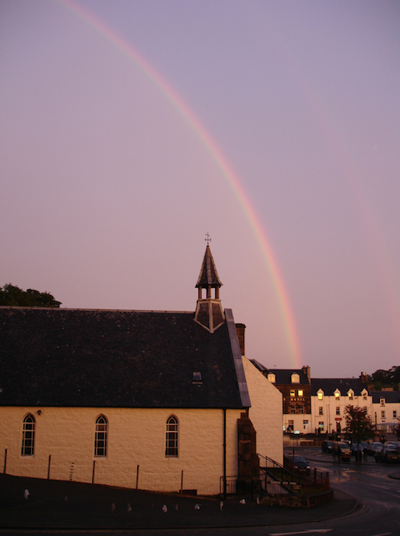 Rainbow in Portree
Rainbow in Portree
Three hikes were on the agenda on Skye. The first was to Coire Laggan, in the Cuillin Hills. It entailed a challenging climb over peat bogs (very boggy, thanks to the rain) and rocks, up to the corrie, or hollow, one of the most spectacular on the island, surrounded by rugged peaks. On the way we were rewarded with views out over the sea towards Rhum and Eigg, two of the “Small Islands” of the Inner Hebrides. At lunch we made our first acquaintance with a “bridie” - a Scottish version of the Cornwall pasty – which may or may not help describe it. All that one really needs to know is that it is a delicious thing which we were destined to see a lot more of because every morning while we were on Skye we were let loose in a bakery to choose our own lunches. And when we find a winner, we tend to stick with it.
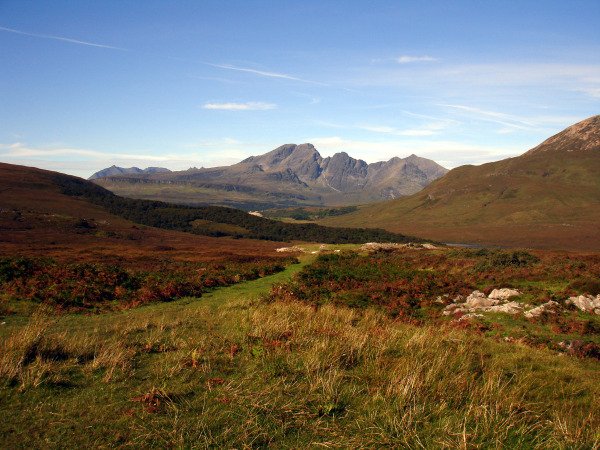 The Black Cuillin Hills
The Black Cuillin Hills
The drive back to Portree necessitated passing the Talisker Distillery. And that in turn necessitated taking a tour, listening to a guide explain more about the production of Scotch than we could possibly absorb, and ending with a tasting, where our powers of absorption were more impressive.
Our second hike was along a coastal path to the ruins of two stone villages, Suisnish and Boreraig, victims of the infamous Clearances. In the late 18th century Scottish landowners began to switch from farming, which supported a large number of tenant farmers and crofters, to sheep rearing, which was more profitable and needed far fewer hands. At the same time, there was lobbying on the part of those who had something to gain from persuading villagers that a better life awaited them in Canada or the United States. Some left willingly, others were evicted forcibly, but all took along with them much of their clan culture. Unlike in most of Europe, there are few remaining examples of traditional peasant life in the Highlands today. Suisnish and Boreraig are ghostly reminders of it, but we visited them on a perfect day, under a cloudless blue sky, with spectacular views out across the water, and it took an effort of imagination to conjure up a sense of the horror of that earlier time.
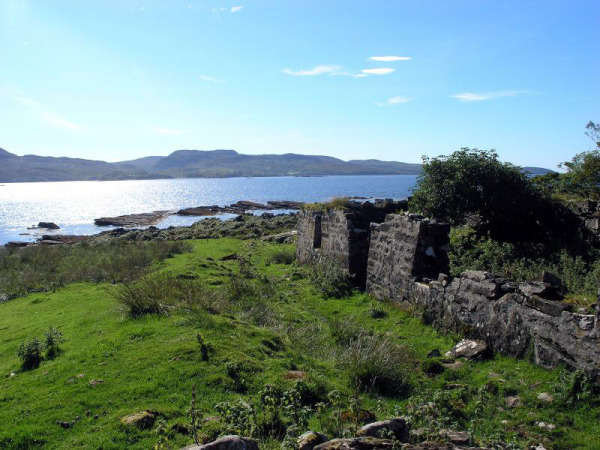 Remnants of a village abandoned during The Clearances
Remnants of a village abandoned during The Clearances
Our last hike took us to the Quiraing, at the north end of the island. We drove first to Kilt Rock, a sheer and dramatic cliff so named because the striations in the rock face resemble a perfectly pleated kilt. Beyond that we tumbled out of the van and started walking in the Quiraing. Almost immediately the weather turned first bad, then awful. Rain and mist reduced visibility to almost nothing, affording only tantalizing glimpses of sheer cliffs and dramatic rock formations for which the Quiraing, a landslip that is still moving, is famous.
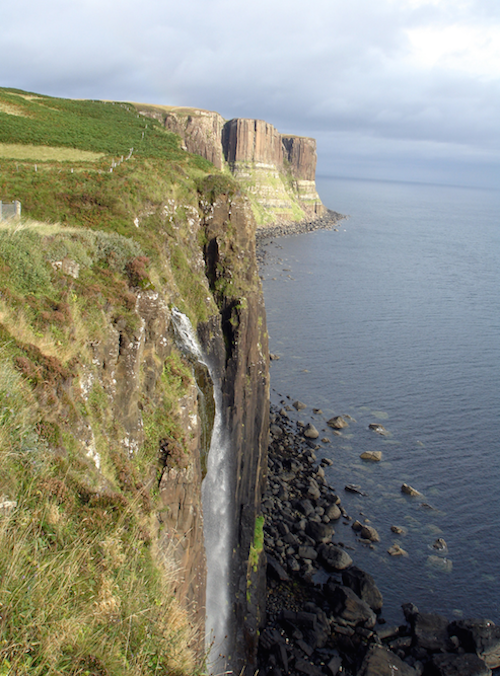 Kilt Rock
Kilt Rock
We returned to the mainland by way of the Skye Bridge, a very short bridge (1,640 feet) that gave rise to a very long-running controversy. Built with private financing, it opened in 1959 as a toll bridge. And a hefty toll, at that; it was described as the most expensive road in Europe. Protests began immediately; ingenious ways to avoid paying the toll were devised (always having a farm animal in one's vehicle was one ploy), and when all else failed – defiant acceptance of jail time for refusal to pay. The protests eventually paid off, and in 2006 the bridge was purchased by the government for £27 million and the tollbooths shuttered once and for all.
After a brief visit to Eilean Donan Castle (a reconstruction, but in such a romantic location that a photograph of it crops up in almost any advertisement having to do with Scotland) we arrived at our hotel on the shore of Loch Maree. It was one of our more interesting hotels. There was a small parlor where we gathered to wait for dinner to be served, and the reading material on offer there consisted solely of newspaper clippings describing the two historic and memorable events in the life of the hotel. The first was the royal visit of Queen Victoria, an occasion of such historical magnitude that subsequent proprietors of the hotel had, it appeared, taken pains to see that nothing had changed since that visit. Certainly not the plumbing. And the royal dust was largely undisturbed because any dusting that had to be done fell to the proprietor's mother, an amiable soul who worked her way around the rooms with dust mop in one hand and a glass of whisky in the other, the latter getting the bulk of her attention. The second but no less celebrated historic event was an outbreak of botulism poisoning which carried off several of the hotel’s guests before medical help could reach them. The culprit appeared to have been some tainted duck paste sandwiches that the unsuspecting guests had eaten, and for some obscure reason this too went down as something worth being remembered and brought to the attention of hotel guests, as the carefully preserved newspaper clippings attested. Reading them while awaiting dinner amd hoping that duck paste wouldn't be on the menu didn’t heighten our appetites, and in such a remote corner of Scotland our expectations weren’t high to begin with but in fact the meal was surprisingly good - even excellent.
The weather the next day was what is euphemistically termed “unsettled.” In this we ventured out on a 14-mile, 8-hour slog replete with bogs and river crossings. The largest river had gathered considerable volume because of the weather but there was no way to avoid crossing it. And those (many of us) who fell in didn't get much wetter than they already were. Along the way we passed two men huddled together in a single “bothy” - a cross between a tent and a rain jacket - waiting hopefully by the edge of the loch to either freeze to death or for their kettle to boil so they could have tea. Only in Britain.
More than compensating for the weather was the bar scene back at the hotel, where we stopped for a drink before dinner. A seemingly subdued and somber family was seated at a large table at the far end, but as the minutes ticked by and the whisky flowed, the group became more animated, and even merry. There was one empty place at the table, with an untouched glass of whisky at it. What we later learned, but couldn't see from where we sat, was that the ashes of one recently deceased “Alfred” had been placed on that empty chair, prior to his family's doing for him what they knew he would want done: first a “wee dram,” followed by the tossing of his remains into the loch where he had spent so many happy hours fishing. By the time we left the bar to go in to dinner it was apparent that poor Alfred was missing an hilarious evening.
We had no hiking for the next two days. On the first, the heavy rain continued, joined now by gale force winds. And on the second we were in the van, making the obligatory tourist stops at Loch Ness, Urquhart Castle, and Culloden on our way to the Cairngorms. The Cairngorms are a mountain range in the eastern Highlands, and feature the highest and the coldest plateaux in Britain. It is Scotland's second largest ski area in winter, but even its designation as the “coldest” has not prevented it from suffering from global warming and lack of snow in recent years. In September it had the feel of any ski resort in the off-season: bleak. We hiked up to the restaurant at the top of the access road, made a brief detour up a small summit (just because it was there, and we are what we are), and then trudged for five miles along a stony, desolate ridge, with a ferocious wind our constant companion.
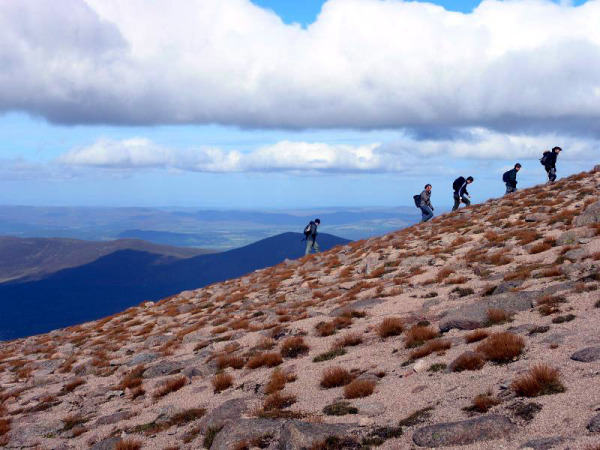 The Cairngorms
The Cairngorms
All that then remained between ourselves and Edinburgh was one more distillery visit, a fair length of Scottish highway, and the Firth of Forth bridge. But what remained after leaving Scotland was a clearer understanding of the country itself, and the nexus between its people, its history and its geography. Far from being merely a chunk of land that happens to be connected to the top of England and part of the United Kingdom, it has a rich culture all its own, and a proud and independent character. We felt fortunate to get a glimpse into that.
click here to see a gallery of the photos
